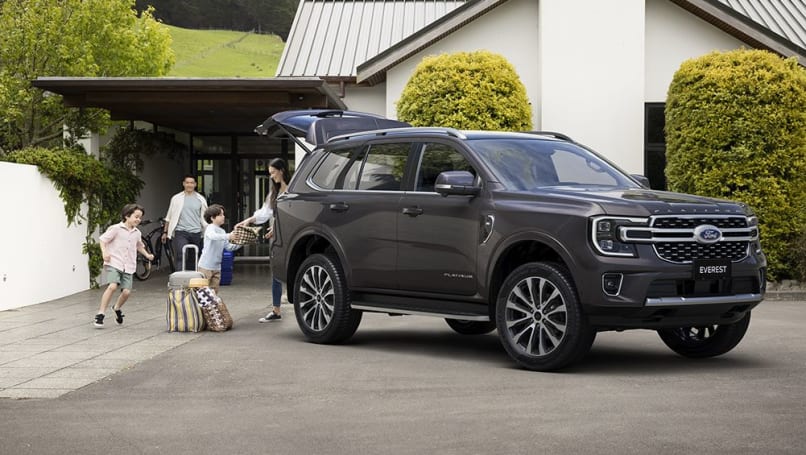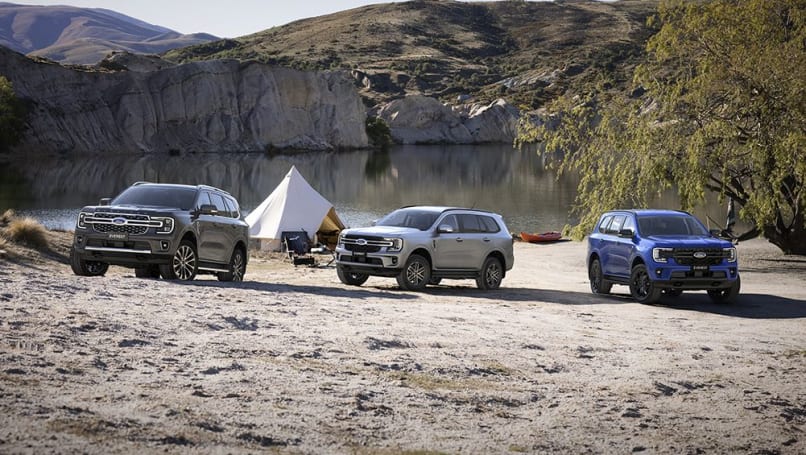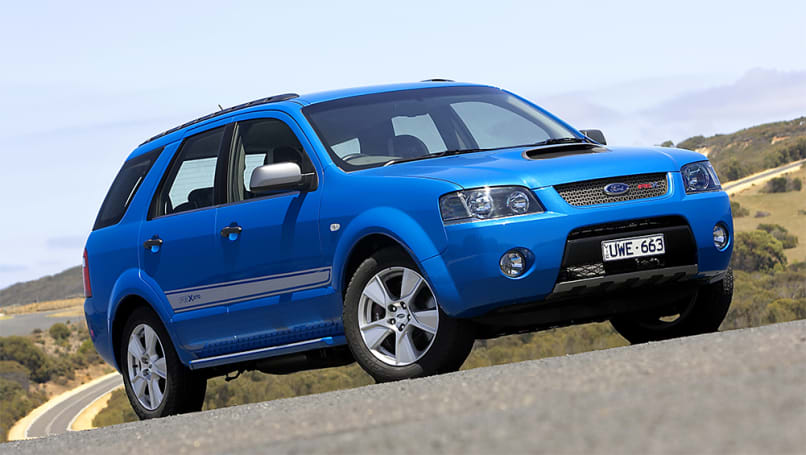
2025 BYD Shark 6 sales scrutinised as rival Kia Tasman ute and plug-in hybrid Ford Ranger PHEV and GWM Cannon Alpha launches loom
BYD Shark 6 fever has well and truly swept over the country, but is it all as...
Browse over 9,000 car reviews

With Ford having finally unveiled the new-generation Everest, speculation has now turned to a Raptor flagship version, for release sometime in the near future.
It doesn’t help that Ford chose the same media day to also pull the covers off the Raptor version of the P703-series Ranger ute, underscoring the many similarities between the U704-series Everest and the Ranger truck that begat it.
Of course, both cars share much of the same T6.2 architecture, with common design, engineering, packaging, powertrain and drivetrain features. They’re even due out around the same time – in the second half of this year.
Anticipating a Raptor version of the Everest is logical conclusion to draw.
Except, we will most likely never see an Everest Raptor, despite the Ranger connection, because the sheer investment in developing a Raptor offshoot would probably never be recouped, even at beyond Ranger Raptor prices.
Here's a breakdown as to why.
While the current, old-shape Ranger Raptor with a 2.0-litre bi-turbo diesel engine starts just shy of $80,000 before on-road costs (already making it one of the most expensive Fords in Australia today), the 2023 Ranger Raptor is likely to cost much more when pricing is revealed later on.
That’s because the Raptor ute has been extensively re-engineered from the Ranger base, starting with a newly minted 3.0-litre twin-turbo V6 petrol engine, unique suspension components and modified bodywork. These come on top of the fresh safety features, updated multimedia, interior redesign and extra equipment.
Collectively, they might push Ranger Raptor pricing well past $90,000 once driveaway prices and the inevitable accessories are factored in. Like we said when the super-ute was revealed in late February, we’re staring at the first $100K Ranger.
Now, in the case of an Everest Raptor, the amount of work required for it to be worthy enough of the badge is even larger. Much larger.

Consider that an Everest Raptor would require significant change to the rear of the body, with new sheetmetal for the wider wheel arches and guards, as well as under-structure, interior and rear tracks.
These would all come at a substantially higher cost compared to the Ranger’s transformation into Raptor, since that did not require the complexity of modifying a station wagon body-style inside and underneath as well as out.
Factor in even more extra development – including modifying the Everest’s unique rear suspension compared to Ranger, the significant cost of crash testing, creating different rear seat interior trim and the hidden panels required to sit within the wider body, and it’s easy to imagine that Raptor-fying an Everest really is like climbing yet another mountain for Ford’s stretched engineering team at Broadmeadows.
Thus, the projected price of an Everest Raptor would also likely blow out into six figures as well.

Which brings us to the other hurdle facing an Everest Raptor – a diminishing pool of potential consumers.
Ranger buyers are not the same as Everest's, with the latter obviously aimed at families or those requiring a seven-seat SUV. In 2021, Ford sold over 50,000 Rangers in Australia, compared to 8300 Everests. Now, supposing that a Raptor grade in each would account for 15 per cent of all volume, that would mean 7500 Ranger Raptors sold against fewer than 1200 Everest Raptors.
While that hypothetical sales projection is not too bad for Everest Raptor, Australia would probably be its biggest market globally, so it wouldn't get much higher than that. That’s because the Everest has been designed specifically to be an affordable large SUV for Asia Pacific, as this is where body-on-frame, truck-derived wagon demand is high due to their relative affordability and rough-road compatibility compared to similarly sized but more expensive monocoque-bodied seven-seater SUVs like the Toyota Kluger and Mazda CX-9. Affordability and accessibility are paramount.
Plus, the new Everest will not be sold in Europe, America, China and India, where affluent buyers might respond to a Raptor version. The exclusion of India, by the way, is a recent thing, and a massive blow to Everest’s global volume aspirations, as Ford only exited that market (except for Mustang and other ‘icon’ models) late last year.

As a result, Everest's remaining big markets, including Thailand (where global production will be centred around) and Vietnam, are more price-sensitive than Australia, meaning potential Raptor demand would be insufficient to warrant introduction.
As one Ford executive told CarsGuide recently, demand for a high-performance luxury flagship version of an Everest (costing around twice as much as the base grade) in the model’s most popular countries is too low to justify the investment.
Even if Ford could produce a wider, pumped-out Everest Raptor within a reasonable budget, in the few markets where pricing is less of an issue with consumers – such as in Australia – the Everest needs to sell better.
Consider that in 2021, Australia’s 8300 Everest sales paled against the 21,300 (severely supply limited at that) units that the Toyota Prado managed. It’s also outsold by the Isuzu MU-X, which found 10,600 buyers last year.

Finally, the T6.2 is expected to be the last iteration of a program started in around 2008, that led to the 2011 T6 Ranger and Mazda BT-50. The latter is now an Isuzu-based truck of course, and while the 2023 model-year Ranger and Everest are substantially new, generationally they date back to early last decade. Their replacements will switch to an all-new architecture currently under development alongside a future Ford F-Series truck in Detroit, and are set to see the light of day in around 2027/28 – just six or seven years from now.
What we’re saying is that time as well as money has likely run out for a T6.2 Everest-based Raptor.
But the dream isn't completely over.
Over the next few years (or even months, according to some rumours), Ford may introduce sports or off-road versions of Everest, like the FX4, but don’t expect to see a 298kW/597Nm 3.0-litre twin-turbo V6 petrol EcoBoost shoehorned into the family-focused SUV as we know it.

As with the locally made Ford Territory Turbo and FPV F6X of the mid-to-late 2000s, while Australians like the sound of an indigenous high-performance SUV hero, they’ll much more likely spend their money on a luxury-branded import or go-faster pick-up truck instead when push comes to shove. You know, with AMG or M badges on the back.
That’s why the Raptor badge will probably never grace an Everest.
For Australians, the nearest thing is the closely-related, T6.2-based, but left-hand-drive-only Bronco Raptor, and that’s only a 14-hour flight away in sunny California…
Comments